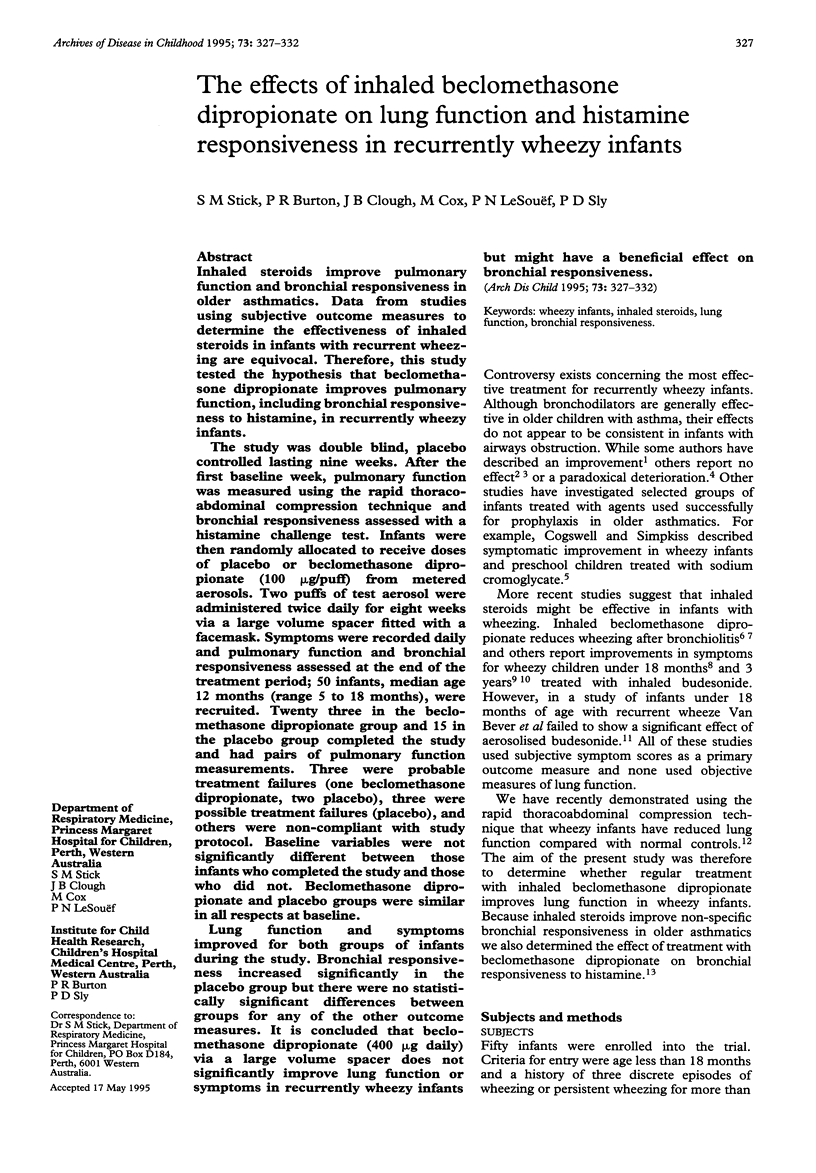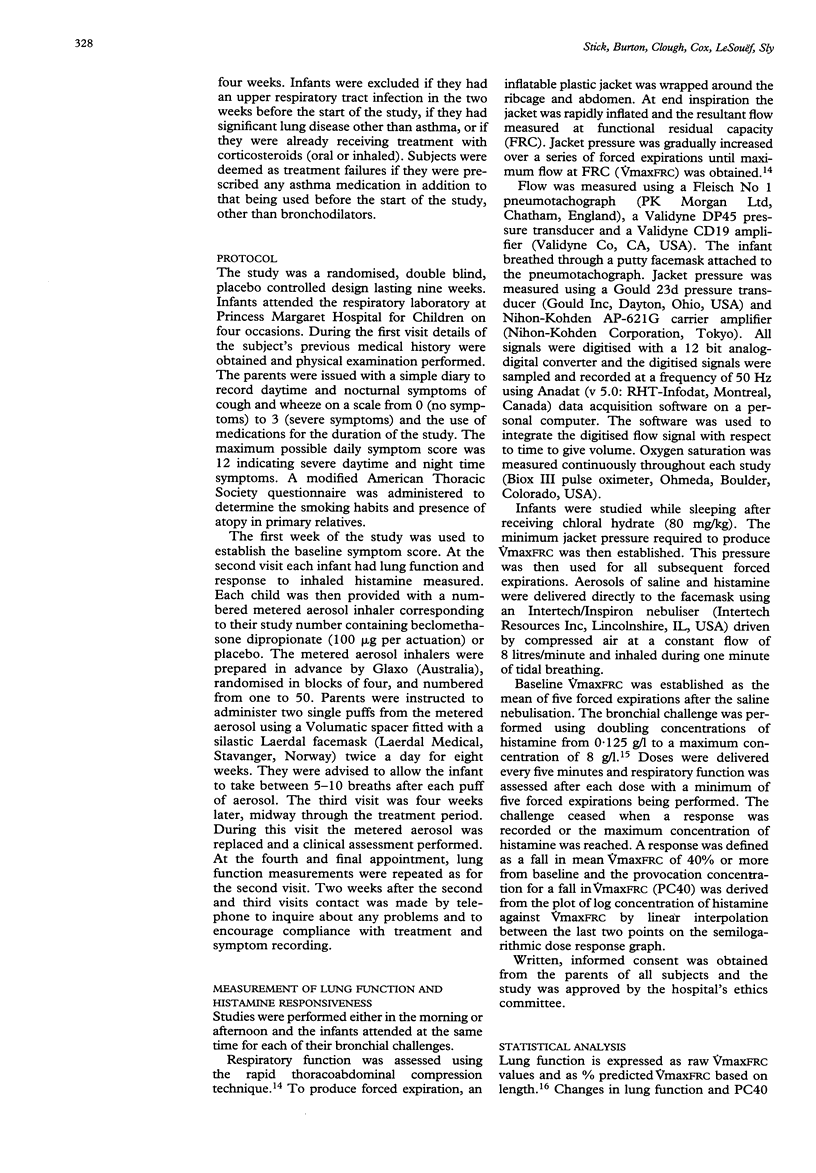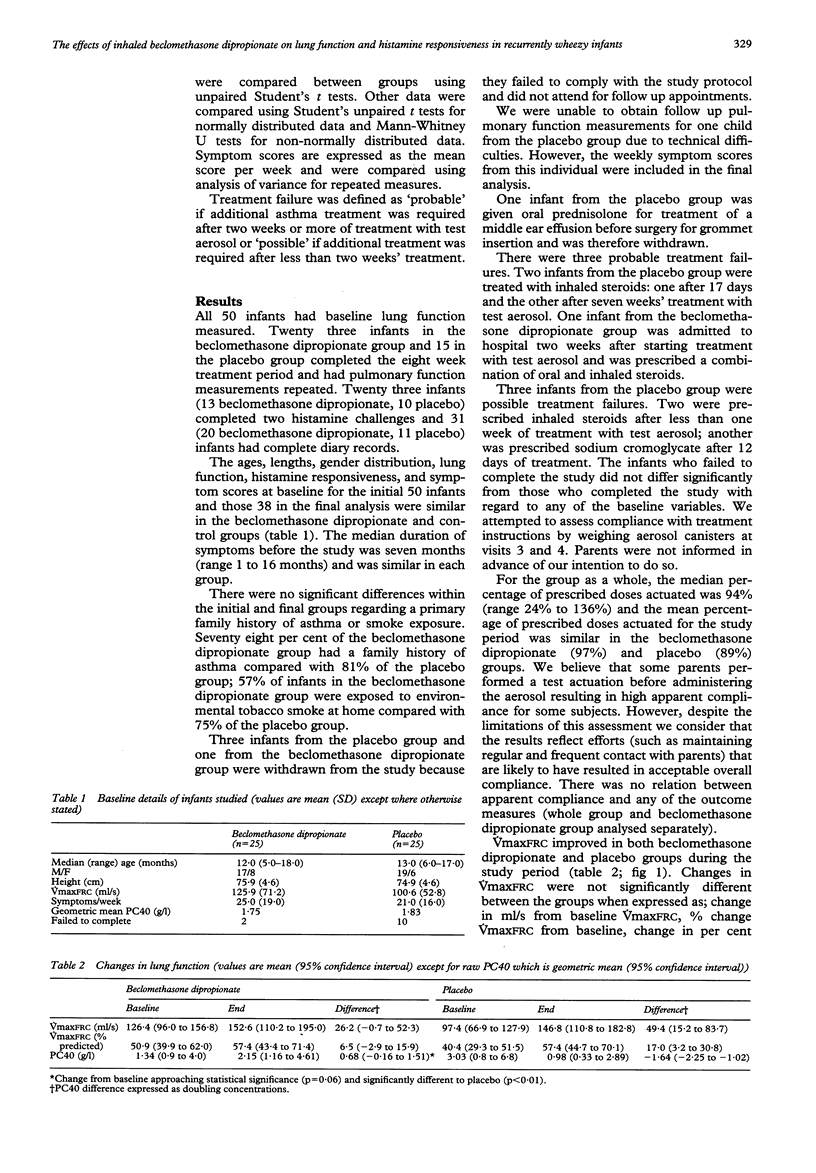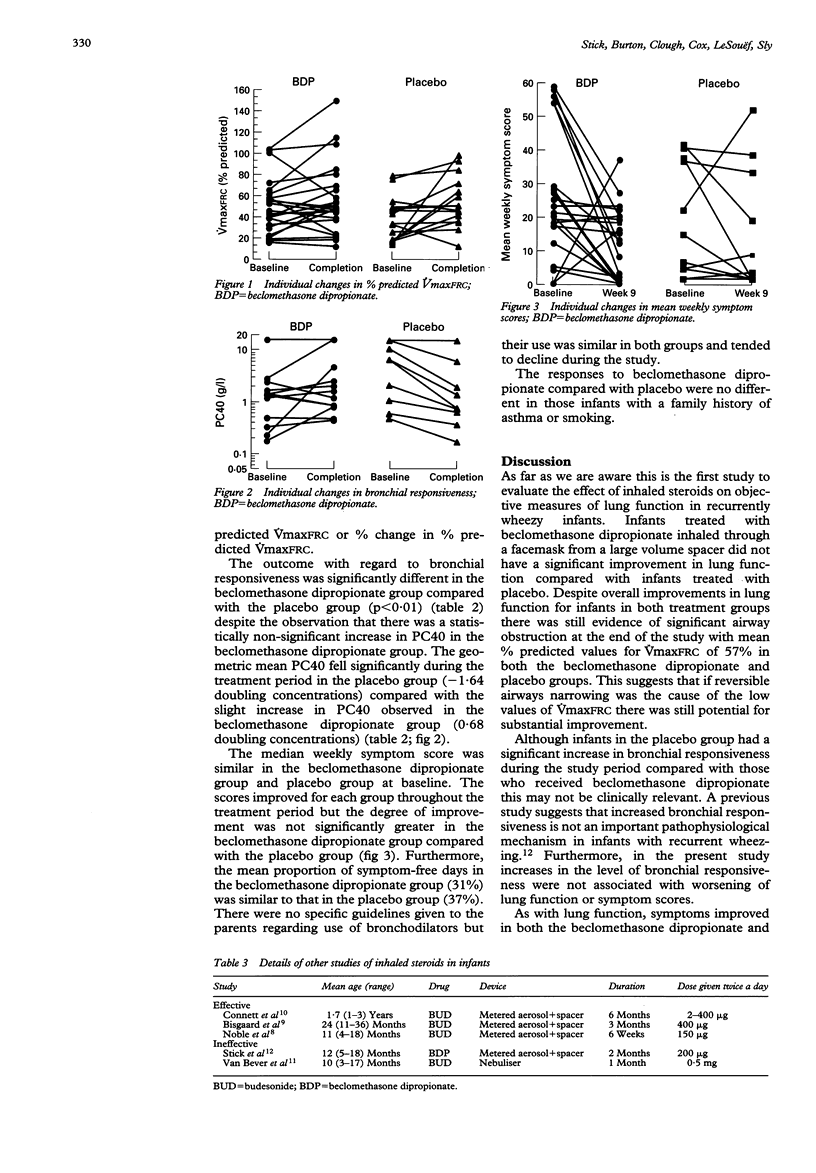Abstract
Inhaled steroids improve pulmonary function and bronchial responsiveness in older asthmatics. Data from studies using subjective outcome measures to determine the effectiveness of inhaled steroids in infants with recurrent wheezing are equivocal. Therefore, this study tested the hypothesis that beclomethasone dipropionate improves pulmonary function, including bronchial responsiveness to histamine, in recurrently wheezy infants. The study was double blind, placebo controlled lasting nine weeks. After the first baseline week, pulmonary function was measured using the rapid thoracoabdominal compression technique and bronchial responsiveness assessed with a histamine challenge test. Infants were then randomly allocated to receive doses of placebo or beclomethasone dipropionate (100 micrograms/puff) from metered aerosols. Two puffs of test aerosol were administered twice daily for eight weeks via a large volume spacer fitted with a facemask. Symptoms were recorded daily and pulmonary function and bronchial responsiveness assessed at the end of the treatment period; 50 infants, median age 12 months (range 5 to 18 months), were recruited. Twenty three in the beclomethasone dipropionate group and 15 in the placebo group completed the study and had pairs of pulmonary function measurements. Three were probable treatment failures (one beclomethasone dipropionate, two placebo), three were possible treatment failures (placebo), and others were non-compliant with study protocol. Baseline variables were not significantly different between those infants who completed the study and those who did not. Beclomethasone dipropionate and placebo groups were similar in all respects at baseline. Lung function and symptoms improved for both groups of infants during the study. Bronchial responsiveness increased significantly in the placebo group but there were not statistically significant differences between groups for any of the other outcome measures. It is concluded that beclomethasone dipropionate (400 microgram daily) via a large volume spacer does not significantly improve lung function or symptoms in recurrently wheezy infants but might hav a beneficial effect on bronchial responsiveness.
Full text
PDF





Selected References
These references are in PubMed. This may not be the complete list of references from this article.
- Bisgaard H., Munck S. L., Nielsen J. P., Petersen W., Ohlsson S. V. Inhaled budesonide for treatment of recurrent wheezing in early childhood. Lancet. 1990 Sep 15;336(8716):649–651. doi: 10.1016/0140-6736(90)92147-a. [DOI] [PubMed] [Google Scholar]
- Burton P. R. Helping doctors to draw appropriate inferences from the analysis of medical studies. Stat Med. 1994 Sep 15;13(17):1699–1713. doi: 10.1002/sim.4780131702. [DOI] [PubMed] [Google Scholar]
- Carlsen K. H., Leegaard J., Larsen S., Orstavik I. Nebulised beclomethasone dipropionate in recurrent obstructive episodes after acute bronchiolitis. Arch Dis Child. 1988 Dec;63(12):1428–1433. doi: 10.1136/adc.63.12.1428. [DOI] [PMC free article] [PubMed] [Google Scholar]
- Cogswell J. J., Simpkiss M. J. Nebulised sodium cromoglycate in recurrently wheezy preschool children. Arch Dis Child. 1985 Aug;60(8):736–738. doi: 10.1136/adc.60.8.736. [DOI] [PMC free article] [PubMed] [Google Scholar]
- Conner W. T., Dolovich M. B., Frame R. A., Newhouse M. T. Reliable salbutamol administration in 6- to 36-month-old children by means of a metered dose inhaler and Aerochamber with mask. Pediatr Pulmonol. 1989;6(4):263–267. doi: 10.1002/ppul.1950060410. [DOI] [PubMed] [Google Scholar]
- Connett G. J., Warde C., Wooler E., Lenney W. Use of budesonide in severe asthmatics aged 1-3 years. Arch Dis Child. 1993 Sep;69(3):351–355. doi: 10.1136/adc.69.3.351. [DOI] [PMC free article] [PubMed] [Google Scholar]
- Everard M. L., Clark A. R., Milner A. D. Drug delivery from holding chambers with attached facemask. Arch Dis Child. 1992 May;67(5):580–585. doi: 10.1136/adc.67.5.580. [DOI] [PMC free article] [PubMed] [Google Scholar]
- Everard M. L., Clark A. R., Milner A. D. Drug delivery from jet nebulisers. Arch Dis Child. 1992 May;67(5):586–591. doi: 10.1136/adc.67.5.586. [DOI] [PMC free article] [PubMed] [Google Scholar]
- Foucard T., Sjöberg O. A prospective 12-year follow-up study of children with wheezy bronchitis. Acta Paediatr Scand. 1984 Sep;73(5):577–583. doi: 10.1111/j.1651-2227.1984.tb09977.x. [DOI] [PubMed] [Google Scholar]
- Kraan J., Koëter G. H., van der Mark T. W., Boorsma M., Kukler J., Sluiter H. J., De Vries K. Dosage and time effects of inhaled budesonide on bronchial hyperreactivity. Am Rev Respir Dis. 1988 Jan;137(1):44–48. doi: 10.1164/ajrccm/137.1.44. [DOI] [PubMed] [Google Scholar]
- Lenney W., Milner A. D. At what age do bronchodilator drugs work? Arch Dis Child. 1978 Jul;53(7):532–535. doi: 10.1136/adc.53.7.532. [DOI] [PMC free article] [PubMed] [Google Scholar]
- Maayan C., Itzhaki T., Bar-Yishay E., Gross S., Tal A., Godfrey S. The functional response of infants with persistent wheezing to nebulized beclomethasone dipropionate. Pediatr Pulmonol. 1986 Jan-Feb;2(1):9–14. doi: 10.1002/ppul.1950020106. [DOI] [PubMed] [Google Scholar]
- Martinez F. D., Morgan W. J., Wright A. L., Holberg C. J., Taussig L. M. Diminished lung function as a predisposing factor for wheezing respiratory illness in infants. N Engl J Med. 1988 Oct 27;319(17):1112–1117. doi: 10.1056/NEJM198810273191702. [DOI] [PubMed] [Google Scholar]
- Noble V., Ruggins N. R., Everard M. L., Milner A. D. Inhaled budesonide for chronic wheezing under 18 months of age. Arch Dis Child. 1992 Mar;67(3):285–288. doi: 10.1136/adc.67.3.285. [DOI] [PMC free article] [PubMed] [Google Scholar]
- O'Callaghan C., Milner A. D., Swarbrick A. Paradoxical deterioration in lung function after nebulised salbutamol in wheezy infants. Lancet. 1986 Dec 20;2(8521-22):1424–1425. doi: 10.1016/s0140-6736(86)92735-2. [DOI] [PubMed] [Google Scholar]
- O'Callaghan C., Milner A. D., Swarbrick A. Spacer device with face mask attachment for giving bronchodilators to infants with asthma. BMJ. 1989 Jan 21;298(6667):160–161. doi: 10.1136/bmj.298.6667.160. [DOI] [PMC free article] [PubMed] [Google Scholar]
- Park E. S., Golding J., Carswell F., Stewart-Brown S. Preschool wheezing and prognosis at 10. Arch Dis Child. 1986 Jul;61(7):642–646. doi: 10.1136/adc.61.7.642. [DOI] [PMC free article] [PubMed] [Google Scholar]
- Radford M. Effect of salbutamol in infants with wheezy bronchitis. Arch Dis Child. 1975 Jul;50(7):535–538. doi: 10.1136/adc.50.7.535. [DOI] [PMC free article] [PubMed] [Google Scholar]
- Silverman M. Bronchodilators for wheezy infants? Arch Dis Child. 1984 Jan;59(1):84–87. doi: 10.1136/adc.59.1.84. [DOI] [PMC free article] [PubMed] [Google Scholar]
- Stick S. M., Arnott J., Turner D. J., Young S., Landau L. I., Lesouëf P. N. Bronchial responsiveness and lung function in recurrently wheezy infants. Am Rev Respir Dis. 1991 Nov;144(5):1012–1015. doi: 10.1164/ajrccm/144.5.1012. [DOI] [PubMed] [Google Scholar]
- Stick S. M., Turner D. J., LeSouëf P. N. Lung function and bronchial challenges in infants: repeatability of histamine and comparison with methacholine challenges. Pediatr Pulmonol. 1993 Sep;16(3):177–183. doi: 10.1002/ppul.1950160308. [DOI] [PubMed] [Google Scholar]
- Tepper R. S., Morgan W. J., Cota K., Wright A., Taussig L. M. Physiologic growth and development of the lung during the first year of life. Am Rev Respir Dis. 1986 Sep;134(3):513–519. doi: 10.1164/arrd.1986.134.3.513. [DOI] [PubMed] [Google Scholar]
- Van Bever H. P., Schuddinck L., Wojciechowski M., Stevens W. J. Aerosolized budesonide in asthmatic infants: a double blind study. Pediatr Pulmonol. 1990;9(3):177–180. doi: 10.1002/ppul.1950090310. [DOI] [PubMed] [Google Scholar]


